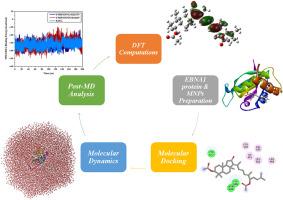探索海洋天然产物以确定作为 EBNA1 抑制剂的候选物质:分子对接、分子动力学和 DFT 计算的启示
IF 2.5
3区 生物学
Q3 BIOCHEMISTRY & MOLECULAR BIOLOGY
Biochemical and biophysical research communications
Pub Date : 2024-10-19
DOI:10.1016/j.bbrc.2024.150856
引用次数: 0
摘要
爱泼斯坦-巴尔病毒(EBV)是一种 DNA 肿瘤病毒,在恶性肿瘤(包括霍奇金淋巴瘤、伯基特淋巴瘤和腹腔癌)中的发病率超过 1%。尽管 EBV 在癌症演变中起着至关重要的作用,但目前还没有发现针对 EBV 的治疗方法。Epstein-Barr 核抗原 1(EBNA1)是 EBV 编码的潜伏蛋白,在所有与 EBV 相关的肿瘤中都会产生,也是这些癌症类型中唯一的潜伏蛋白。EBNA1 蛋白在维持、繁殖和 EBV 基因组分离中起着多重作用,因此可作为治疗 EBV 相关恶性肿瘤的一个有吸引力的治疗靶点。在过去的几十年中,人们一直在尝试开发专门的 EBNA1 抑制剂,以减少 EBNA1 的表达或阻碍 EBNA1 依赖的过程,但目前还没有一种抑制剂获得批准。作为抗病毒候选药物的潜在来源,海洋天然产物(MNPs)引起了人们的极大兴趣。为了寻找抑制 EBV 繁殖的强效候选药物,我们利用对接计算和分子动力学模拟(MDS)挖掘了一个包含超过 14,000 种化合物的 MNP 数据库,以寻找可能的 EBNA1 抑制剂。根据 200 ns MDS 的结合能(ΔGbinding)估算,与 KWG 相比,UMHMNP351444649 和 UMHMNP134128179 与 EBNA1 的结合亲和力更高,ΔGbinding 值分别为 -35.6、-33.3 和 -32.4 kcal/mol。通过对 UMHMNP351444649 和 UMHMNP134128179 与 EBNA1 复合物的结构和能量研究,揭示了这些抑制剂在 EBNA1 结合位点内的巨大恒定性。此外,鉴定出的 MNPs 还具有良好的物理化学和药物化学特性。最后,还进行了密度泛函理论计算,结果证实了对接计算和 MDS 的结果。这些发现建议将 UMHMNP351444649 和 UMHMNP134128179 作为潜在的抗EBV 候选药物,并进一步进行体外和体内试验。本文章由计算机程序翻译,如有差异,请以英文原文为准。

Exploring marine natural products for identifying putative candidates as EBNA1 inhibitors: An insight from molecular docking, molecular dynamics, and DFT computations
Epstein-Barr virus (EBV), namely a DNA neoplasm virus, is liable for over 1 % of malignant neoplasms involving Hodgkin's and Burkitt's lymphoma as well as ventral cancer. Despite the crucial role of EBV in carcinoma evolution, no treatment has been discovered yet against EBV. Epstein-Barr nuclear antigen 1 (EBNA1), the EBV-encoded latent protein, is produced in all EBV-linked neoplasms and is the only latent protein in these cancer types. EBNA1 protein has multiple roles in the upkeep, reproduction, and EBV genome separation and can thus act as an attractive therapeutic target for treating EBV-related malignancies. In the past few decades, attempts have been made to develop specialized EBNA1 inhibitors to reduce EBNA1 expression or obstruct EBNA1-relied processes, but none has been approved yet. Marine natural products (MNPs) have garnered significant interest as potential sources of antiviral drug candidates. In seeking potent drug candidates to inhibit EBV reproduction, an MNP database containing >14,000 compounds was mined to hunt putative EBNA1 inhibitors using docking computations and molecular dynamics simulations (MDS). On the basis of binding energy (ΔGbinding) estimations over 200 ns MDS, UMHMNP351444649 and UMHMNP134128179 revealed a greater binding affinity towards EBNA1 compared to KWG, with ΔGbinding values of −35.6, −33.3, and −32.4 kcal/mol, respectively. Structural and energetical investigations of UMHMNP351444649 and UMHMNP134128179 complexed with EBNA1 were inspected, unveiling the great constancy of these inhibitors within the EBNA1 binding site. Moreover, the identified MNPs demonstrated favorable physicochemical and medicinal chemistry characteristics. Finally, density functional theory calculations were executed, and the results assured the outcomes obtained from docking computations and MDS. These findings proposed UMHMNP351444649 and UMHMNP134128179 as potential anti-EBV drug candidates that warrant further in-vitro and in-vivo assays.
求助全文
通过发布文献求助,成功后即可免费获取论文全文。
去求助
来源期刊
CiteScore
6.10
自引率
0.00%
发文量
1400
审稿时长
14 days
期刊介绍:
Biochemical and Biophysical Research Communications is the premier international journal devoted to the very rapid dissemination of timely and significant experimental results in diverse fields of biological research. The development of the "Breakthroughs and Views" section brings the minireview format to the journal, and issues often contain collections of special interest manuscripts. BBRC is published weekly (52 issues/year).Research Areas now include: Biochemistry; biophysics; cell biology; developmental biology; immunology
; molecular biology; neurobiology; plant biology and proteomics

 求助内容:
求助内容: 应助结果提醒方式:
应助结果提醒方式:


